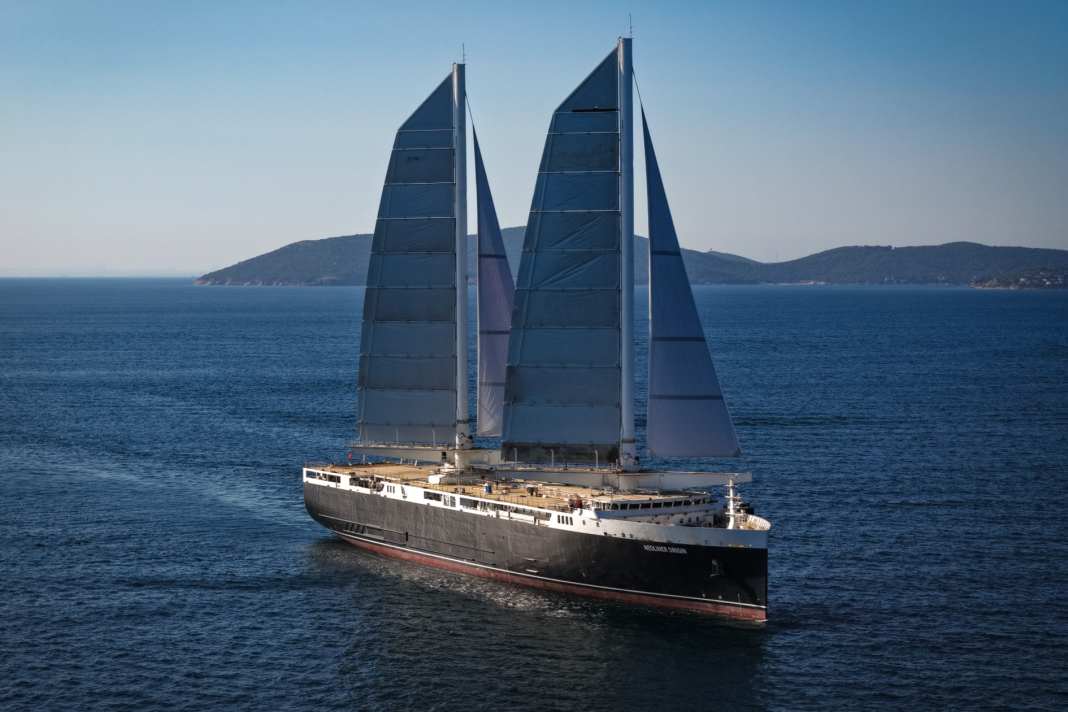





The innovative "Roll on Roll off" cargo ship, the "Neoliner Origin", set off on its first Atlantic crossing on Thursday. This was announced by the Nantes-based shipping company Neoline. In eight days, the 136 metre long cargo ship will cross the Atlantic with sails as its main propulsion and reach the port of Saint-Pierre et Miquelon in Canada.
From there, the ship will continue its journey four days later to Baltimore, where it is due to arrive on 29 October. It will then continue on to Halifax before the freighter embarks on its journey home. This route will be travelled regularly in future.
Innovative technology for sustainable shipping
With a hybrid drive consisting of sails and electric and diesel engines, it should be possible to reduce the consumption of fossil fuels by over 80 per cent. Greenhouse gas emissions could even be reduced by 90 per cent. The two mainsails made of specially developed carbon unfurl like an accordion.
The ship has a total sail area of 3,000 square metres, consisting of two mainsails of 1,050 square metres each and two additional sails of 450 square metres each. This means that speeds of around eleven knots can be achieved. The masts, which are around 90 metres high, can be folded down, reducing the overall height to around 42 metres - a decisive advantage when entering harbours with bridge boundaries.
Technical data of the "Neoliner Origin":
- Charge: 5300 tonnes or 265 standard containers (20 tonnes)
- Hybrid drive: 3300 kW diesel engine + 900 kW electric drive
- speed10 knots purely electric, 14.5 knots (diesel-electric)
- ShapeComparatively slim shape and extendable "anti-drift" blades
Many years of development work
Behind the sailboat is the French company Neoline, which was founded by shipping experts. The aim is to use sails to significantly reduce emissions in the container transport market. The "Neoliner Origin" was launched in Istanbul in January 2025. It was built at the RMK shipyard. Around 700 engineers were involved in the construction of the 136-metre-long ship. According to the shipping company, more than twelve years of development work went into the project.
Michel Pery, co-founder of Neoline, explains the challenges that had to be overcome as follows:
A merchant ship must be reliable; we can only adopt mature solutions. We can't afford to experiment. So we looked at what technologies were mature and readily available, and apart from the sails, there wasn't much.
More on the topic:
Three-stage concept for low-emission shipping
Jean Zanuttini, also co-founder of Neoline and President of the company, names three steps behind the project. The first is to rely on wind power as the main drive. This would be slower overall, but could almost halve the energy required. Added to this is intelligent routing, which makes it possible to rely more on sailing power.
"On land, as a second step, we are relying on shore power," explains Zanuttini. There are also batteries on board, the capacity of which is to be expanded in the future. It should then also be possible to carry out harbour manoeuvres and trips in calm conditions electrically. The third step is to replace diesel with alternative fuels. Hydrogen could take its place. This would allow electricity to be produced, which would then be used for propulsion.
Competitiveness despite challenges
Zanuttini comments on the competitiveness with regular container ships:
This ship is one of the largest sailing cargo ships ever built. It is clearly competitive with ships of the same size; we can prove that our costs are about the same.
Although the ship has significantly more equipment, sails and hybrid engines, this is balanced out by a significantly lower fuel requirement.
One challenge, however, is that other ships are significantly larger for transatlantic transport and can offer correspondingly lower prices. The aim is to compensate for this disadvantage by primarily targeting customers from the immediate vicinity of the departure and destination ports. This should shorten the transport routes on land and overcome the cost difference.
At this point, you will find external content that complements the article. You can display and hide it with a click.
Renowned partners and home port
A number of well-known companies were involved in the project right from the start. In addition to Renault and spirits manufacturers such as Hennessy and Remy Cointreau, the French Beneteau Group and Longchamp are also involved. Both Longchamp and Hennessy want to transport their products using the cargo ships, as company representatives said at the launch of the boat in Istanbul at the beginning of the year.
They emphasise the desire to reduce greenhouse gas emissions during the transport of goods. In the case of Hennessy, it is also about going back to the origins. Hennessy bottles were already being transported to the USA by sailing ship at the end of the 18th century. The home port of the "Neoliner Origin" is Saint-Nazaire in France.
Technical innovation for optimised route planning
The ship uses a special weather routing system to optimise the use of the sails and the ideal route. This was developed by the French company D-ICE Engineering. This system makes it possible to predict weather conditions and adapt the route accordingly in order to optimise the use of sailing power.
According to Zanuttini, this is an essential part of the concept, as it allows more reliance to be placed on wind power, thereby minimising the use of the auxiliary engine. Thanks to intelligent route planning, the "Neoliner Origin" could be a reliable and environmentally friendly alternative despite its lower speed compared to conventional cargo ships.
You can find more information about the project here.

